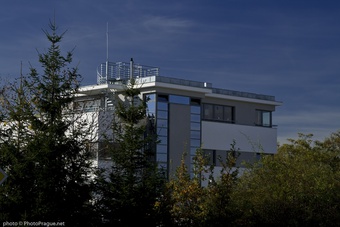
Functionalism
Purism, Constructivism or Functionalism are the terms that try to name various aspects of a major architectural development that literally overwhelmed the European architectural scene in the twenties. It comes as a kind of conclusion to a passionate search for a new modern architecture. It started with the refusal of Historicism, went through the Art Nouveau period and ended by the non-acceptance of any ornamentation that would disturb the "play of architectural volumes in the sun". Thanks to people like Le Curbusier or Ludwig Mies van der Rohe, the new architectural model proposed white buildings with large windows running along walls that came back to the roots of architectural spatial composition. Prague had been one of the main centres of this new architectural concept since the beginning. In Prague, Functionalism wasn´t only a passing fad, it was seriously developed from a theoretical point of view as well as practical. Thanks to the talent and enthusiasm of an entire generation of young architects, Prague became an internationally significant architectural laboratory.
To many Functionalist architects, the idea of a house was that it was a "machine for living". In their theoretical essays, they use expressions such as "The form must follow the function", architecture in their eyes was a science which must not have any artistic ambitions. Nonetheless, some architects contested such "scientific" Functionalism and searched for pure architectural beauty, ideal proportions, the poetics of ocean liners or to capture the atmosphere of summer days. Looking back, we could say
that time has reconciled these two poles. Even the "most scientific" interwar buildings were designed with a sense of proportion and harmony, and they are still breathing the everlasting poetry of beautiful ideas.
The first Functionalist buildings in Prague are situated in the historical environment of the New Town. The architects had to respect the historical space traditionally devoted to buildings and that gave birth to the specific type of "Prague Functionalist Building". There is on Wenceslas Square the Baťa house, the Lindt house by architect Ludvík Kysela from 1925 - 1929, the Juliš Hotel by architect Pavel Janák from 1927 - 1933, the arcade "Černá Růže" (Black Rose) in Na Příkopě Street by architect Oldřich Tyl from 1929 - 1933, or the Olympic Palace in Spálená Street by architect Jaromír Krejcar from 1925 - 1926. The largest Functionalistic structure in Prague is "Veletržní Palác" (Trade Fair Palace) by architects Oldřich Tyl and Josef Fuchs (Praha-Holešovice, built from 1924 to 1928), which today houses the collections of modern art owned by the Prague National Gallery. The Functionalist concept applied to family houses is best symbolized by the residential village named Baba in Prague 6 that has great realisations by the most renowned Czech interwar architects. The abrupt end of Functionalist architecture was brought about by WW 2 and the German occupation. That is also why Czech Functionalism came to symbolize the "golden age" of artistic achievement in architecture which was then consciously carried on through the rest of the 20th century.







